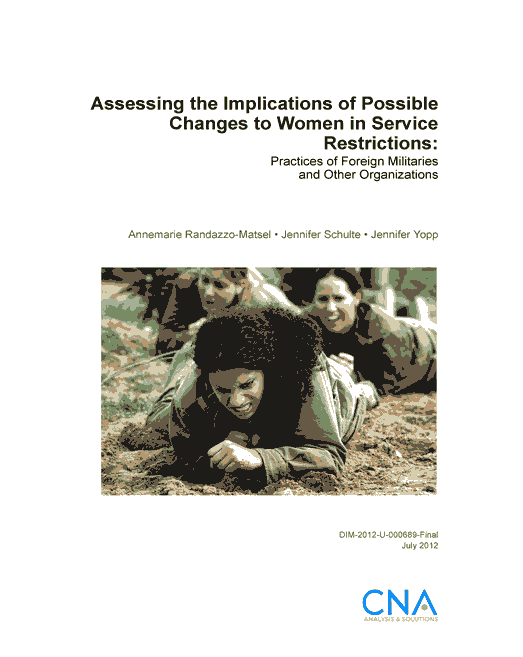Assessing the Implications of Possible Changes to Women in Service Restrictions
Executive Summary
As part of its review of restrictions to women’s service in certain military occupations and assignments, the Assistant Commandant of the Marine Corps asked CNA to examine the practices of foreign militaries and other physically demanding professions. In this report, we review the policies and practices of four foreign militaries —Australia, the United Kingdom, Canada, and Israel—and two physically demanding professions—fire fighting (including smokejumpers) and Special Weapons and Tactics (SWAT) policing—to determine what can be learned about women’s physical abilities and the effects of gender integration on unit (or organizational) dynamics.
Australia recently repealed its policies excluding women from certain ground combat positions and will begin assigning women to ground combat trades by 2013. The Australian Defence Force (ADF) will rely on gender-neutral Physical Employment Standards (PESs) to determine who is eligible to serve in each of its trades, including ground combat. With appropriate training, most men and women have passed the All-Corps Soldier PES. The ADF has not yet tested any women using the Combat Arms PES or any of the ground combat trade PESs, so it is unclear what percentage of women can meet the physical standards of these professions.
The United Kingdom recently upheld its policies excluding women from ground close combat occupations. It did find that a small percentage of women (no more than 1 percent of trained women and 0.1 percent of women in general) could meet its requirements for service in ground combat. The Minister of Defence maintains that gender integrating such units could have potentially harmful effects on cohesion, which could in turn hurt combat effectiveness. Despite these concerns, however, the United Kingdom allows women to serve in the attached arms (as supporting personnel, such as medics, clerks, and logisticians) for units that engage in ground close combat in the British Army and Royal Marines at the battalion level and below.
In Canada, which allows women to serve in all military occupations and units, women make up only 2 percent of the combat arms occupations, and no woman has served in the elite Joint Task Force 2 (i.e., the antiterrorist unit). Studies showed that, in the early years of gender-integrated combat units, recruiting and attrition were both problematic. According to a 1997 study, some reasons for this were women’s lower physical strength/endurance, negative instructor attitudes toward women, and social and psychological barriers. In recent years, however, women have successfully led ground combat units in combat in Afghanistan.
Israel allows women to serve in non-close-combat roles voluntarily. The majority of women who who fill these roles serve in the Caracal combat unit or the Border Patrol. Despite the policy allowing such service, evidence suggests that women in combat units are sometimes removed from these units based on the objections of religious male soldiers in the unit..
Unlike the U.S. military, commercial professions such as fire fighting and SWAT policing cannot—by law—exclude women. The physical demands of these professions, however, make them unattractive or out of reach to many, though not all, women.
Overall, the evidence from our review of other countries and professions shows that at least a small percentage of women were able to meet the physical demands of ground combat service or physically taxing occupations. We also found, however, that gender-integrating units and occupations can be challenging.
Download reportCleared for Public Release; Distribution Unlimited.
Specific authority: N00014-11-D-0323.
Details
- Pages: 112
- Document Number: DIM-2012-U-000689-Final
- Publication Date: 7/20/2012
